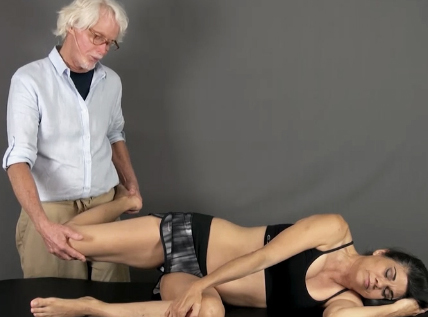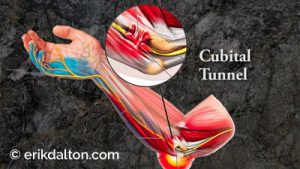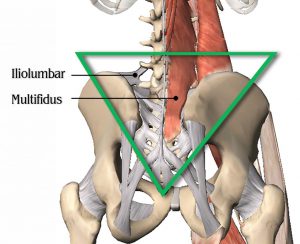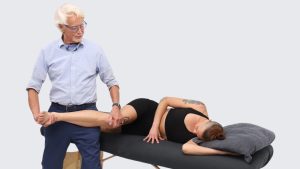While performing the sidelying quad stretch shown in this week’s MAT video, the client reported radiating thigh pain as I brought her hip into extension and knee into flexion. Sometimes when I encounter this, it’s hard to tell if the brain has the rectus femoris muscle locked in protective spasm or if the pain is due to overstretching of an entrapped femoral nerve.

Since the femoral nerve exits the lumbar spine from L2- L4, compression can occur anywhere along the route starting at the spine, through the iliopsoas, under the inguinal ligament and into the soft tissues of the quads. This large nerve controls muscles that help extend the leg and move the hips, and it also provides feeling to the lower leg and anterior thigh. When injured or inflamed, the femoral nerve may set off a chain reaction causing the brain to spread pain into the genital region. Biomechanically, it may be difficult for the client to extend the knee while the nerve is inflamed, resulting in altered gait and compensatory strain elsewhere. During assessment, if the client reports sharp, burning quad or groin pain, try this femoral nerve flossing technique and retest.
In addition to manual therapy techniques, stretching and strengthening exercises, aerobic conditioning, and cognitive-behavioral education have been shown to be valuable in the treatment of those with nerve entrapments in the hip region. Graded exposure stretching, whether performed independently by the client or by the manual therapist appears to be helpful in relieving femoral nerve compression due to lumbar spine pathology (L2-L4) or musculotendinous entrapment. However, aggressive stretching can be irritating to the nerve and must be controlled in a slow and progressive manner.
Targeted strengthening exercises help facilitate proper load transfer between the lumbosacral spine, pelvis, hip, and lower extremity, and for those with chronic pelvic pain, non-symptom provoking pelvic floor exercises may be helpful. Aerobic conditioning is also useful due to the positive effect it has on overall pain management and to get mood-boosting hormones such as DOSE (dopamine, oxytocin, serotonin and endorphins) flowing, always assure the client they are being heard and respected. It’s important to stay present and engaged from the time they walk in the door. Cognitive behavioral therapy assists the client in gaining a sense of control over their pain by providing an understanding of pain mechanisms and coping strategies. The therapeutic goal of bodywork and corrective exercise is to tilt the balance away from stress and toward relaxation. Below are a couple of techniques I’ve found helpful in reducing pain and improving function is those clients presenting with femoral nerve symptoms.

Femoral Nerve Mobilization (L2- L4) (left sidelying)
ACTION:
- Client uses both hands to grasp her bottom knee towards her chest.
- Therapist’s left hand grasps client’s right ankle and his right hand grasps her knee
- Therapist steps behind client’s knee as it is brought into flexion
- With right hand on her knee and his left securing her ankle, the therapist can create knee flexion or hip extension
- Therapist gently extends client’s hip to painful femoral nerve barrier and backs off to the inter-barrier zone
- The client tucks her chin to traction the femoral nerve
- To floss the nerve distally, the therapist gently adds knee flexion as the client brings her head back to neutral
On sale this week only!
Save 25% off the Treating Trapped Nerves course!
NEW enhanced video USB Format!
Equip yourself with a powerhouse of skills for relieving painfully compressed nerves. Relieve pain caused by mechanical entrapment in the neck, thoracic outlet, sacroiliac, and other regions. Save 25% this week only. Offer expires midnight Monday, October 21st!
Click here for more information and to purchase the course for 16 CE hours and a certificate of completion to display in your office.
BONUS: Order the home study version and get access to the eCourse for free!







